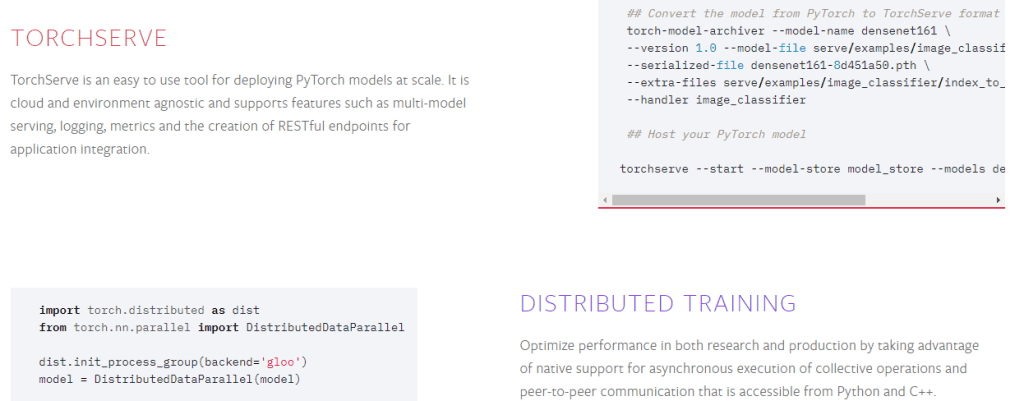PyTorch is a highly innovative and comprehensive machine-learning framework that is primarily based on the Torch library. It has been specifically designed to cater to a broad array of applications, including computer vision and natural language processing. PyTorch is a Python package offering two high-level features: Tensor computation (akin to NumPy) with robust GPU acceleration and deep neural networks built on a tape-based autograd system. This synthesis of flexibility, modularity, stability, and support makes it an excellent tool for both research and production purposes.
How Does It Work?
Operating PyTorch is straightforward. Users begin by selecting their preferences and running the install command. The ‘Stable’ option represents the most currently tested and supported version of PyTorch. Once installed, users can leverage PyTorch’s flexible tensor library, which includes a powerful GPU-accelerated tensor computation engine. Additionally, PyTorch’s dynamic neural networks are built on an autograd system, allowing for sophisticated model creation and training.
Key Features

PyTorch stands out among machine learning frameworks due to its unique and powerful features.
- Tensor Computation: Like NumPy, PyTorch offers tensor computation, but with an added advantage – strong GPU acceleration. This ensures efficient and quick computations, a necessity for large-scale applications.
- Deep Neural Networks: Built on a tape-based autograd system, PyTorch enables the creation of dynamic computation graphs, a contrast to other tools that only permit static computation graphs. This flexibility allows for more complex model creation and training.
- Robust Ecosystem: PyTorch is backed by a robust ecosystem of tools and libraries that support a wide range of applications, from computer vision to natural language processing. This makes it a versatile tool for a variety of machine-learning tasks.
- Distributed Training: PyTorch supports distributed training, meaning computational work can be distributed among multiple CPU and GPU systems. This feature is crucial for handling large datasets and complex computations.
- ONNX Support: PyTorch natively supports Open Neural Network Exchange (ONNX), enabling models to be exported to other deep learning frameworks. This interoperability is crucial in a production environment where different tools may be used.
- Mobile Support: Although still experimental, PyTorch’s mobile support is a promising feature for deploying machine learning models on mobile devices.
- Hybrid Front-End: PyTorch provides a hybrid front-end that offers ease of use and flexibility during both the research and production phases.
- Optimized Performance: With its optimized performance, PyTorch ensures that resources are utilized efficiently, leading to quicker results and lower computational costs.
These features collectively make PyTorch a comprehensive and powerful tool for both research and production in machine learning.
Benefits to Users

PyTorch’s versatility and flexibility have made it a popular choice among researchers and developers. Its dynamic computation graphs allow users to change the behavior of the graph on the fly, a feature that has proven beneficial in a variety of complex applications. Moreover, PyTorch’s strong GPU acceleration ensures efficient computation, thereby speeding up the model training process.
Pros
- Versatile and flexible, allowing for easy experimentation
- Extensive support and community backing
- Dynamic computation graphs enable more complex model creation
- Strong GPU acceleration ensures efficient computation
- Open-source nature promotes continuous improvement and transparency
Pricing and Value for Money
While PyTorch is an open-source tool and free to use, there are associated costs depending on the extent of its application. For instance, if you’re using cloud infrastructures like Google Cloud or AWS, there are usage fees involved. According to information available on Google Cloud Marketplace, the PyTorch-kit usage fee includes vCPU Based Pricing: USD 0.13/hour (USD 94.90/month) for all.
Additionally, if you’re utilizing AWS, the costs would depend on your configuration choices. However, it’s worth noting that using PyTorch with AWS Inferentia can reduce inference costs by up to 71%, making it a cost-effective solution for businesses scaling out their machine-learning operations.

For those interested in contributing more directly to the PyTorch community, there’s also an option to join The PyTorch Foundation. Membership costs vary, with a LF Silver Membership + $150,000 for one tier, and a sliding scale fee for another. However, academic and nonprofit organizations can join for free.
In terms of value for money, PyTorch provides immense value given its powerful features, flexibility, and extensive support ecosystem. Although there might be associated costs for computational resources or cloud services, the benefits gained from utilizing this robust machine-learning framework can outweigh these expenses.
Conclusion and Recommendation
In conclusion, PyTorch is a robust, flexible, and user-friendly machine-learning framework. Its dynamic computation graphs, coupled with strong GPU acceleration and an extensive support ecosystem, make it an excellent choice for both researchers and developers. Whether you’re delving into the world of deep learning or looking to deploy sophisticated models in production, PyTorch is a tool that can handle it all. Therefore, it is highly recommended for anyone interested in machine learning and deep learning.
